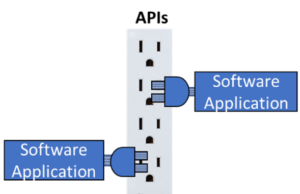- Significant development in VA’s API office: Myklegard moves to OMB
- API – accessing Veterans’ data like plugging into a wall socket… sort of
- APIs are a win-win: enable VA to lower its costs while unleashing the power of the private sector
Last week saw a significant development in the Veterans Affairs (VA) Office of Information and Technology (OIT) Product Engineering organization. Most notably was VA Drew Myklegard’s announcement of his leaving VA/OIT for an assignment at Office of Management and Budget (OMB). Drew was an outstanding leader in VA’s Lighthouse API effort. OMB is fortunate to have him.
API Defined
 API stands for Application Programming Interface. An API is a piece of software that helps two pieces of software exchange data with each other. It is like a bridge between two islands, or better yet, like a software electrical outlet that other software applications can plug into. APIs are efficient connectors because their specifications are published, thereby making it easy to build a software “plug” to be inserted into the API “outlet”. APIs simplify software development as they obviate the need to build custom point-to-point connections to other software applications with which they exchange data.
API stands for Application Programming Interface. An API is a piece of software that helps two pieces of software exchange data with each other. It is like a bridge between two islands, or better yet, like a software electrical outlet that other software applications can plug into. APIs are efficient connectors because their specifications are published, thereby making it easy to build a software “plug” to be inserted into the API “outlet”. APIs simplify software development as they obviate the need to build custom point-to-point connections to other software applications with which they exchange data.
In VA, APIs are a solution to the massive bird’s nest of point-to-point interfaces between VA software applications. As point-to-point interfaces build up over time, their maintenance exponentially consumes resources that otherwise could be spent on buying or building applications that directly help Veterans. Since the VA software inventory is now over 800 applications, that equates to potentially hundreds of thousands of individual point-to-point software interfaces to maintain.
Imagine if, in place of wall outlets in your family room, you had live electrical wires hanging out of holes in the walls. Rather than plugging a TV into an outlet, you decide to cut off the TV plug and individually connect the TV wires to the wall wires. That’s time-consuming, unsafe and likely to blow up the TV and all other devices and appliances on that circuit. This is similar to the challenge faced by programmers who must build point-to-point interfaces between software applications. It is complex, time-consuming, labor-intensive work. And regression testing a series of disparate applications with point-to-point interfaces is a nightmare.
the TV wires to the wall wires. That’s time-consuming, unsafe and likely to blow up the TV and all other devices and appliances on that circuit. This is similar to the challenge faced by programmers who must build point-to-point interfaces between software applications. It is complex, time-consuming, labor-intensive work. And regression testing a series of disparate applications with point-to-point interfaces is a nightmare.
Myklegard: The Lighthouse leader moves to OMB
Drew Myklegard, formerly Executive Director of Product Engineering in VA/OIT, has been detailed to OMB to serve as Associate Deputy Federal CIO. While in VA/OIT, Drew led the VA “Lighthouse” initiative to create and implement an API-forward software development policy. With the support of Charles Worthington’s (CTO) office and top cover from Jim Gfrerer (CIO) and myself (DevOps), Drew and his team built an API library of “software outlets” to make accessing VA data simple and secure. This short VA API video summarizes their efforts and achievements.
Not only did Drew’s team introduce and spread the concept of APIs as a better alternative to internal software point-to-point interfaces, but they took an extraordinary step of creating public-facing APIs, which unlocked the power, resources, speed, and innovation of the private sector to create “killer apps” for Veterans.
Unleashing the power of the private sector to serve Veterans
As powerful as APIs are at reducing cost and complexity within the walls of VA’s software enterprise, they become infinitely more powerful when APIs serve as a secure portal to connect external private sector applications to VA data.
Today, the vast majority of software applications in the VA and Federal markets are “of the government, by the government and for the government”. Citizens’ needs are specified by government sponsors, acquired (bought, borrowed, or built) by government employees and contractors, and operated by government-owned or contracted data centers – all with taxpayer funds. In this government ecosystem, contractors wait for the government to collect requirements and post a solicitation, then bid, win, and receive taxpayers’ funds to implement a solution. Not only is this process complex, slow, and expensive, but it limits solutions to those that are sanctioned by the government.
Public-facing APIs disrupt the paradigm: “Only government-approved solutions are worthy”
 By enabling simple and secure access to data through VA public-facing APIs, VA has unleashed $Trillions in private sector financial and intellectual capital to solve problems and serve Veterans and other communities. Through these APIs, individuals and organizations can apply their own resources (not tax dollars) and innovative ideas to build custom applications that deliver helpful tools and services that compete for citizens’ and Veterans’ attention.
By enabling simple and secure access to data through VA public-facing APIs, VA has unleashed $Trillions in private sector financial and intellectual capital to solve problems and serve Veterans and other communities. Through these APIs, individuals and organizations can apply their own resources (not tax dollars) and innovative ideas to build custom applications that deliver helpful tools and services that compete for citizens’ and Veterans’ attention.
One outstanding example is the VA API that enables Veterans to see their own health records on their Apple iPhone. The beauty of this model is that VA did not pay to build the Apple Health app. The capital investments and program risks were borne by the private sector, in this case, Apple.
By aligning stakeholders’ interests with resources, market incentives, and technology, Veterans and citizens benefit from private sector innovation that produces outcomes at the speed of need.

0 Comments